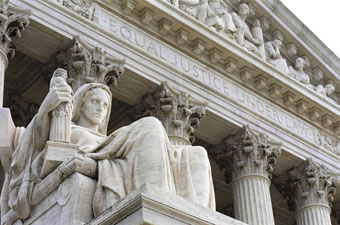The Eighth Circuit Gets It Right by Daniel Blomberg, Legal Counsel of the Becket Fund for Religious Liberty
Media Contact
Ryan Colby 202-349-7219 media@becketlaw.org

 by Daniel Blomberg, Legal Counsel of the Becket Fund for Religious Liberty
by Daniel Blomberg, Legal Counsel of the Becket Fund for Religious Liberty
Yesterday, the U.S. Court of Appeals for the Eighth Circuit split with seven other U.S. Courts of Appeal, issuing two opinions ruling that the HHS Mandate violates the Religious Freedom Restoration Act. While the Eighth Circuit was in good company (12 other appellate judges had already come to a similar conclusion, and the vast majority of over two dozen district courts had as well), it is the first circuit to issue a merits ruling that went the right way on this issue. That creates a circuit conflict which will make it even more likely that one of the seven petitions currently pending before the U.S. Supreme Court will be taken up in the coming term.
The Eighth Circuit concluded that the Mandate imposes a substantial burden on religious exercise and that the government feasibly had less restrictive ways to accomplish its interests without imposing that burden. The court started its analysis by applying the proper substantial-burden test: where “sincerity is not in dispute,” courts cannot “second-guess” objectors’ beliefs and instead “must…determine whether the government has placed substantial pressure” on the objectors to abandon the “religious…exercise at issue.” Op.13, 17. The test was easy to apply: there “has never been a question” that “a direct monetary penalty to coerce conduct that violates religious belief” constitutes “a substantial burden,” and here, the penalty “mirrors” the one already recognized as a “substantial burden” by the Supreme Court in Hobby Lobby.” Op.12.
The court avoided the pitfall that the other circuits had fallen into: it rejected HHS’s argument that the burden on the ministries should be ignored because (HHS claims) that there’s an “independent obligation” on the ministries’ health-plan administrators to provide the abortion-inducing drugs. The court recognized this as a retread of the argument “rejected…in Hobby Lobby” for being “tantamount to ‘tell[ing] the [religious objectors] that their beliefs’ about complicity…were ‘flawed.’” Op.19 (alterations in original). Regardless of whether there were obligations on others, the scheme still “compels” the ministries “to act in a manner that they sincerely believe would make them complicit,” and that meant the ministries’ beliefs were burdened. Op.18. Further, the “government’s own litigation behavior” belied its insistence that the forms were a redundant form of hand-raising that simply let the government know that the ministries didn’t want to provide abortion drugs. Op.19. Rather, submitting the forms “accomplishes” what the government wanted to achieve and the ministries wanted to avoid: “the provision of objectionable coverage through their group health plans.” Id. (emphasis supplied).
Notably, the government recently admitted to the Supreme Court that the Eighth Circuit is correct on this last, crucial point: at least for self-insured plans, the government’s scheme does make “contraceptive coverage…part of the…ERISA plan…provided by the employer.” Gov’t BIO at 19, ETBU v. Burwell, No. 15-35 (September 2015). Would that the government had let other circuits know before it led them astray. See, e.g., Grace Schools v. Burwell, 2015 WL 5167841, at *15 (7th Cir. Sept. 4, 2015) (holding turning on the assertion that the government’s scheme “does not use the health plans” of self-insured religious nonprofits “at all” and, in fact, “refus[ed] to use the health plans.”); id. at *21, 23 (Manion, J., dissenting) (unmasking the scheme as “a purposely complicated act of bureaucratic legalese and accounting tricks” which, in fact, does “us[e] nonprofits, their health plans and their contractual relationships with their insurers and TPAs to provide the contraceptive coverage to which they object”).
Since it had found a substantial burden, the Eighth Circuit then turned the question of whether the government had a good enough reason to force ministries to violate their sincere beliefs. This was also an easy out: the government bore the burden of proof that “no alternative means would suffice,” and its scant record failed to show that “mak[ing] contraceptives available to employees through its own healthcare exchanges” or “community health centers, public clinics, and hospitals” are not “feasible means to distribute cost-free contraceptives.” Op.21, 24.